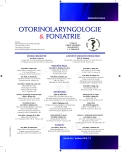The Significance of Galectin-3 Expression in Glottic Laryngeal Squamous Cell Carcinoma
Authors:
D. Kalfeřt 1,2; P. Čelakovský 1; D. Ludvíková 3,4
Authors‘ workplace:
Klinika otorinolaryngologie a chirurgie hlavy a krku, Univerzita Karlova v Praze, Lékařská fakulta v Hradci Králové, Fakultní nemocnice Hradec Králové
1; Klinika ORL, foniatrie, sluchová protetika, s. r. o., Plzeň
2; Ústav biologie, Univerzita Karlova v Praze, Lékařská fakulta v Plzni
3; Ústav patologie, Univerzita Karlova v Praze, 1. lékařská fakulta, Všeobecná fakultní nemocnice v Praze
4
Published in:
Otorinolaryngol Foniatr, 65, 2016, No. 2, pp. 76-81.
Category:
Original Article
Overview
Introduction:
The aim of our study was to assess the significance of galectin-3 expression in glottic laryngeal squamous cell carcinoma in relation to the clinicopathological parameters.
Material and methods:
Retrospective study. The study included 58 patients who had undergone surgical resection glottic laryngeal squamous cell carcinoma at The Department of Otorhinolaryngology and Head and Neck Surgery, University Hospital in Hradec Kralove, during the years 2001–2009. Paraffin-embedded blocks of all studied carcinomas were retrieved from archive file of The Fingerland Department of Pathology, University Hospital in Hradec Kralove. Subsequently, galectin-3 expression was detected in all carcinomas. The results of expression were statistically analyzed in relation to clinicopathological parameters.
Results:
Galectin-3 was expressed in 31 (53.5%) patients. Galectin-3 expression did not statistically correlate with clinicopathological parameters.
Conclusion:
The role of galectin-3 expression in glottic laryngeal squamous cell carcinoma remains unclear. Although in accordance with the results of recent studies, it is possible for said marker seen as a potential prognostic and predictive and should be the subject of further studies.
KEYWORDS:
galectin-3, squamous cell carcinoma of the larynx, glottic
Sources
1. Almadori, G., Bussu, F., Cadoni, G. et al.: Molecular markers in laryngeal squamous cell carcinoma: towards an integrated clinicobiological approach. Eur. J. Cancer, 41, 2005, 5, s. 683-693.
2. Betka, J., Plzak, J., Smetana, K., Jr. et al.: Galectin-3, an endogenous lectin, as a tool for monitoring cell differentiation in head and neck carcinomas with implications for lectin-glycan functionality. Acta. Otolaryngol., 123, 2003, 2, s. 261-263.
3. Bosnjak, I., Selthofer-Relatic, K., Vcev, A.: Prognostic value of galectin-3 in patients with heart failure. Dis. Markers, 2015, s. 690205.
4. Čada, Z., Plzák, J., Chovanec, M. et al.: Galektiny v dlaždicových karcinomech hlavy a krku. Čas. Lék. Čes., 147, 2008, 11, s. 559-563.
5. Čelakovský, P., Kalfeřt, D., Chrobok, V. et al.: Klinický význam a možnosti detekce mikrometastáz u dlaždicobuněčného karcinomu hlavy a krku. Otorinolaryngol. Foniat. /Prague/, 62, 2013, 4, s. 209-213.
6. Gillenwater, A., Xu, X. C., El-Naggar, A. K. et al.: Expression of galectins in head and neck squamous cell carcinoma. Head Neck, 18, 1996, 5, s. 422-432.
7. Honjo, Y., Inohara, H., Akahani, S. et al.: Expression of cytoplasmic galectin-3 as a prognostic marker in tongue carcinoma. Clin. Cancer Res., 6, 2000, 12, s. 4635-4640.
8. Choi, J. Y., Cho, S. I., Do, N. Y. et al.: Clinical significance of the expression of galectin-3 and Pim-1 in laryngeal squamous cell carcinoma. J. Otolaryngol. Head Neck Surg., 39, 2010, 1, s. 28-34.
9. Kalfeřt, D., Ludvíková, M.: Nádorové markery u dlaždicových karcinomů hlavy a krku. Onkologie, 6, 2012, 5, s. 241-247.
10. Kong, H., Cui, J., Wang, L. et al.: The expression of galectin-3 and VEGF in laryngeal squamous cell carcinoma. Lin Chung Er Bi Yan Hou Tou Jing Wai Ke Za Zhi, 23, 2009, 3, s. 109-112.
11. Laco, J., Ryska, A., Cap, J. et al.: Expression of galectin-3, cytokeratin 19, neural cell adhesion molecule and E-cadhedrin in certain variants of papillary thyroid carcinoma. Česk. Patol., 44, 2008, 4, s. 103-107.
12. Ludvíková, M., Pešta, M., Holubec, L., Jr. et al.: Nové aspekty patobiologie nádorů. Česk. Patol., 45, 2009, 4, s. 94-99.
13. Miranda, F. A., Hassumi, M. K., Guimaraes, M. C. et al.: Galectin-3 overexpression in invasive laryngeal carcinoma, assessed by computer-assisted analysis. J. Histochem. Cytochem., 57, 2009, 7, s. 665-673.
14. Piantelli, M., Iacobelli, S., Almadori, G. et al.: Lack of expression of galectin-3 is associated with a poor outcome in node-negative patients with laryngeal squamous-cell carcinoma. J. Clin. Oncol., 20, 2002, 18, s. 3850-3856.
15. Plzak, J., Betka, J., Smetana, K., Jr. et al.: Galectin-3 - an emerging prognostic indicator in advanced head and neck carcinoma. Eur. J. Cancer, 40, 2004, 15, s. 2324-2330.
16. Saussez, S., Camby, I., Toubeau, G. et al.: Galectins as modulators of tumor progression in head and neck squamous cell carcinomas. Head Neck, 29, 2007, 9, s. 874-884.
17. Silva, S. D., Nonogaki, S., Soares, F. A. et al.: p16 (INK4a) has clinicopathological and prognostic impact on oropharynx and larynx squamous cell carcinoma. Braz. J. Med. Biol. Res., 45, 2012, 12, s. 1327-1333.
18. Smilek, P.: Molekulární prediktory u nádorů hlavy a krku. Klin. Onkol., 23, 2010, 4, s. 218-223.
19. Sobin, L. H. (ed.), Wittekind,. Ch. (ed.): TNM klasifikace zhoubných novotvarů. 6. vyd., 2000, česká verze 2004. Praha, Ústav zdravotnických informací a statistiky České republiky, 2004.
20. Tamas, L., Szentkuti, G., Eros, M. et al.: Differential biomarker expression in head and neck cancer correlates with anatomical localization. Pathol. Oncol. Res., 17, 2011, 3, s. 721-727.
21. Thijssen, V. L., Heusschen, R., Caers, J. et al.: Galectin expression in cancer diagnosis and prognosis: A systematic review. Biochim. Biophys. Acta, 1855, 2015, 2, s. 235-247.
Labels
Audiology Paediatric ENT ENT (Otorhinolaryngology)Article was published in
Otorhinolaryngology and Phoniatrics

2016 Issue 2
Most read in this issue
- Aspiration Cytology Versus Perioperative Histology in the Diagnosis of Thyroid Nodules
- Adult Xanthogranuloma in Supraclavicular Region
- Vocal Cord Kinematics – New Evaluation Parameters
- New Therapeutic Procedures in Otolaryngology Using Mesenchymal Stromal Cells
